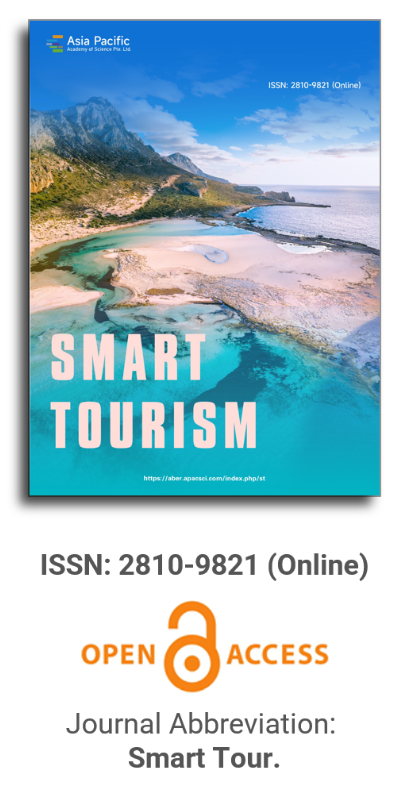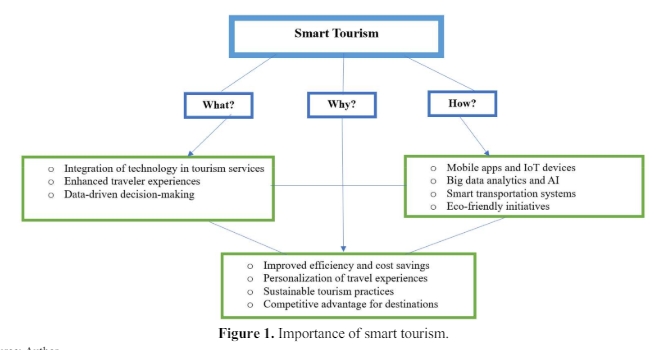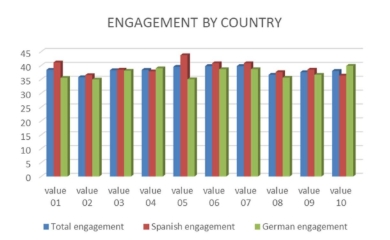


A review of foreign research on the application of virtual reality technology in tourism
Vol 1, Issue 1, 2020
Download PDF
Abstract
As an emerging technology in recent years, virtual reality technology has penetrated people’s fields of material production and life. Nowadays, with the development of technology, the impact of virtual reality technology on the tourism industry is becoming more and more obvious. This paper sorts out and studies the literature of virtual reality and virtual tourism in the past 50 years, discusses the definition of virtual reality and the development of virtual reality technology, sorts out the virtual tourism literature in chronological order, and summarizes the four development stages of virtual tourism. Finally, the existing developments and shortcomings are summarized, and some suggestions for future development are proposed.
Keywords
References
- Burdea G, Coiffet P. Virtual reality technology. Presence: Teleoperators and Virtual Environments 2003; 12(6): 663–664.
- Steuer J. Defining virtual reality: Dimensions determining telepresence. Journal of Communication 1992; 42(4): 73–93.
- Ryan ML. Narrative as virtual reality: Immersion and interactivity in literature and electronic media. Maryland: Johns Hopkins University Press; 2001.
- Helsel SK, Roth JP. Virtual reality, theory, practice and promise. Information Today Incorporated; 1991.
- Hobson JSP, Williams AP. Virtual reality: A new horizon for the tourism industry. Journal of Vacation Marketing 1995; 1(2): 124–135.
- Bryson S. Virtual reality in scientific visualization. Communications of the ACM 1996; 39(5): 62–71.
- Bob C, Oliver R. Understanding hypermedia: From multimedia to virtual reality. Phaidon 1993.
- Miller DC, Thorpe JA. Simnet: The advent of simulator networking. Proceedings of the IEEE 1995; 83(8): 1114–1123.
- Quinn J. Welcome to the pleasure dome. Challenges and Negotiations for Women in Higher Education 2007; (2): 117–129.
- Kim BD, Kim SO. A new recommender system to combine content-based and collaborative filtering systems. The Journal of Database Marketing 2001; 8(3): 244–252.
- Frew AJ. A critical analysis of tourism information technology research. Barcelona: Information and Communication Technologies; 2000; p. 39–52.
- Papson S. Spuriousness and tourism: Politics of two Canadian provincial governments. Annals of Tourism Research 1981; 8(2): 220–235.
- Sutherland IE. The ultimate display. Multimedia: From Wagner to Virtual Reality; 1965.
- Boorstin DJ. The image: A guide to Pseudo-events in America. London: Vintage; 2012.
- Palmer A, McCole P. The role of electronic commerce in creating virtual tourism destination marketing organizations. International Journal of Contemporary Hospitality Management 2000; 12(3): 198–204.
- Cheong R. The virtual threat to travel and tourism. Tourism Management 1995; 16(6): 417–422.
- Lutz B, Weintke M. Virtual Dunhuang art cave: A cave within a cave. Computer Graphics Forum. UK: Blackwell Publishers Ltd.; 1999. p. 257–264.
- Williams AP. Hobson JSP. Tourism—the next generation: Virtual reality and surrogate travel, is it the future of the tourism industry. New York: Night Shade Books; 1994. p. 283–290.
- Musil S, Pigel G. Can tourism be replaced by virtual reality technology. Information and Communications; 1994.
- Goodall B, Pottinger G, Dixon T, et al. Heritage property, tourism and the UK disability discrimination act. Property Management 2004; 22(5): 345–357.
- Huh C, Singh AJ. Families travelling with a disabled member: Analyzing the potential of an emerging niche market segment. Tourism and Hospitality Research 2007; 7(3–4): 212–229.
- Law R, Bai B. Website development and evaluations in tourism: A retrospective analysis. Information and Communication Technologies in Tourism 2006; (3): 1–12.
- Afsarmanesh H, Camarinha-Matos LM. Future smart-organizations: A virtual tourism enterprise. Proceedings of the First International Conference on Web Information Systems Engineering; New York: IEEE; 2000. p. 456–461.
- Illum SF, Ivanov SH, Liang Y. Using virtual communities in tourism research. Tourism Management 2010; 31(3): 335–340.
- Paquet E, Viktor HL. Long-term preservation of 3D cultural heritage data related to architectural sites. Proceedings of the ISPRS Working Group 2005; (4): 1–8.
- Stone P. Niche tourism: Contemporary issues, trends and cases. London: Routledge; 2005.
- Cignoni P, Scopigno R. Sampled 3D models for CH applications: A viable and enabling new medium or just a technological exercise. Journal on Computing and Cultural Heritage 2008; 1(1): 1–23.
- Toubekis G, Mayer I, Doring-Williams M, et al. Preservation and management of the UNESCO world heritage site of Bamiyan: Laser scan documentation and virtual reconstruction of the destroyed Buddha figures and the archaeological remains. 22nd CIPA Symposium; 2009; Kyoto. Kyoto: Japan; 2011.
- Callieri M, Cignoni P, Ganovelli F, et al. Visualization and 3D data processing in the David restoration. Computer Graphics and Applications 2004; 24(2): 16–21.
- Beraldin JA, Picard M, El-Hakim SF, et al. Virtualizing a byzantine crypt by combining high-resolution textures with laser scanner 3D data. Proceedings of the 8th International Conference on Virtual Systems and Multi Media; 2002.
- El-Hakim S, Gonzo L, Voltolini F, et al. Detailed 3D modelling of castles. International Journal of Architectural Computing 2007; 5(2): 199–220.
- Sussmann S, Vanhegan HJ. Virtual reality and the tourism product substitution or complement. European Conference on Information System; 2000.
- Govers R, Go FM, Kumar K. Virtual tourism destination image innovating measurement methodologies. Journal of Travel Research 2005; 39(1): 1–23.
- Champion EM. Cultural Learning in Virtual Environments. VSMM; Ogaki: Department of Electrical and Electronic Engineering; 2004. p. 17–19.
- Gratzer M, Werthner H, Winiwarter W. Electronic business in tourism. International Journal of Electronic Business 2004; 2(5): 450–459.
Supporting Agencies
Copyright (c) 2020 Si Wang, Huihui Yan, Fengxia Wang
License URL: https://creativecommons.org/licenses/by/4.0

This site is licensed under a Creative Commons Attribution 4.0 International License (CC BY 4.0).

Prof. Hung-Che Wu
Nanfang College, Guangzhou
China
Indexing & Archiving
Asia Pacific Academy of Science Pte. Ltd. (APACSCI) specializes in international journal publishing. APACSCI adopts the open access publishing model and provides an important communication bridge for academic groups whose interest fields include engineering, technology, medicine, computer, mathematics, agriculture and forestry, and environment.



.jpg)
.jpg)

.jpg)

